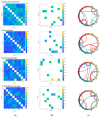Distinct Effects of Brain Activation Using tDCS and Observational Practice: Implications for Motor Rehabilitation
- PMID: 38391749
- PMCID: PMC10886768
- DOI: 10.3390/brainsci14020175
Distinct Effects of Brain Activation Using tDCS and Observational Practice: Implications for Motor Rehabilitation
Abstract
Complex motor skills can be acquired while observing a model without physical practice. Transcranial direct-current stimulation (tDCS) applied to the primary motor cortex (M1) also facilitates motor learning. However, the effectiveness of observational practice for bimanual coordination skills is debated. We compared the behavioural and brain causal connectivity patterns following three interventions: primary motor cortex stimulation (M1-tDCS), action-observation (AO) and a combined group (AO+M1-tDCS) when acquiring a bimanual, two-ball juggling skill. Thirty healthy young adults with no juggling experience were randomly assigned to either video observation of a skilled juggler, anodal M1-tDCS or video observation combined with M1-tDCS. Thirty trials of juggling were performed and scored after the intervention. Resting-state EEG data were collected before and after the intervention. Information flow rate was applied to EEG source data to measure causal connectivity. The two observation groups were more accurate than the tDCS alone group. In the AO condition, there was strong information exchange from (L) parietal to (R) parietal regions, strong bidirectional information exchange between (R) parietal and (R) occipital regions and an extensive network of activity that was (L) lateralized. The M1-tDCS condition was characterized by bilateral long-range connections with the strongest information exchange from the (R) occipital region to the (R) temporal and (L) occipital regions. AO+M1-tDCS induced strong bidirectional information exchange in occipital and temporal regions in both hemispheres. Uniquely, it was the only condition that was characterized by information exchange between the (R) frontal and central regions. This study provides new results about the distinct network dynamics of stimulating the brain for skill acquisition, providing insights for motor rehabilitation.
Keywords: action observation; effective connectivity; electroencephalogram; motor skill acquisition; observational learning; transcranial direct-current stimulation.
Conflict of interest statement
The authors declare no conflicts of interest.
Figures




Similar articles
-
Transcranial direct-current stimulation combined with attention increases cortical excitability and improves motor learning in healthy volunteers.J Neuroeng Rehabil. 2020 Feb 19;17(1):23. doi: 10.1186/s12984-020-00665-7. J Neuroeng Rehabil. 2020. PMID: 32075667 Free PMC article.
-
Electroencephalography correlates of transcranial direct-current stimulation enhanced surgical skill learning: A replication and extension study.Brain Res. 2019 Dec 15;1725:146445. doi: 10.1016/j.brainres.2019.146445. Epub 2019 Sep 11. Brain Res. 2019. PMID: 31520611 Clinical Trial.
-
The effect of action observation combined with high-definition transcranial direct current stimulation on motor performance in healthy adults: A randomized controlled trial.Front Hum Neurosci. 2023 Mar 1;17:1126510. doi: 10.3389/fnhum.2023.1126510. eCollection 2023. Front Hum Neurosci. 2023. PMID: 36936614 Free PMC article.
-
Beneficial effects of cerebellar tDCS on motor learning are associated with altered putamen-cerebellar connectivity: A simultaneous tDCS-fMRI study.Neuroimage. 2020 Dec;223:117363. doi: 10.1016/j.neuroimage.2020.117363. Epub 2020 Sep 9. Neuroimage. 2020. PMID: 32919057
-
The Effect of a Single Session of Non-Invasive Brain Stimulation on Balance in Healthy Individuals: A Systematic Review and Best Evidence Synthesis.Brain Connect. 2021 Nov;11(9):695-716. doi: 10.1089/brain.2020.0872. Epub 2021 Sep 3. Brain Connect. 2021. PMID: 33798002
References
-
- Hodges N.J. Observations on Action-Observation Research: An Autobiographical Retrospective Across the Past Two Decades. Kinesiol. Rev. 2017;6:240–260. doi: 10.1123/kr.2017-0016. - DOI
Grants and funding
LinkOut - more resources
Full Text Sources

